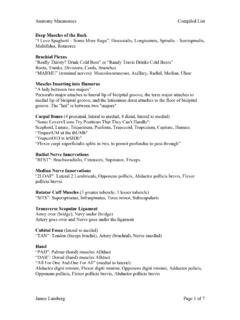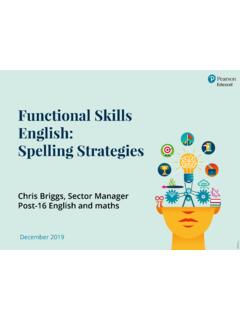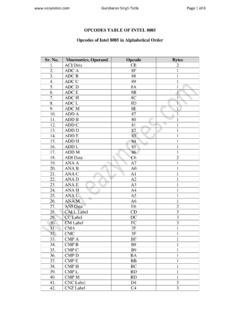Transcription of 9 Types of Mnemonics for Better Memory - UCF
1 Student Academic Resource Center Adapted from: Congos, Dennis H. (2011) Starting Out in Community , Il: McGraw-Hill Division of Student Development and Enrollment Services 9 Types of Mnemonics for Better Memory Mnemonics are Memory devices that help learners recall larger pieces of information, especially in the form of lists like characteristics, steps, stages, parts, etc. We knew back in 1967 from a study by Gerald R. Miller that Mnemonics increased recall. He found that students who regularly used mnemonic devices increased test scores up to 77%!
2 Many Types of Mnemonics exist and which type works best is limited only by the imagination of each individual learner. The 9 basic Types of Mnemonics presented in this handout include Music, Name, Expression/Word, Model, Ode/Rhyme, Note Organization, Image, Connection, and Spelling Mnemonics . 1. Music Mnemonics How many lyrics to songs do you remember? How did you come to remember them? Music is a powerful Memory technique and it can work just as well in school, also. Many learners have made songs out of information when a list of items must be learned.
3 Advertising on radio and TV uses this technique to help potential customers remember their products when shopping. You can make a song or jingle using any type of music you choose for any list of items. Music Mnemonics work best with long lists. For example, some children learn the ABC s by singing the ABC song. Other children learn all the states in alphabetical order using the 50 Nifty United States song. 2. In a Name Mnemonic, the 1st letter of each word in a list of items is used to make a name of a person or thing.
4 An example is: a. ROY G. BIV = colors of the spectrum (Red, Orange, Yellow, Green, Blue, Indigo, Violet.) 3. Name of Expression Mnemonics This is by far the most popularly used mnemonic. To make an Expression or Word mnemonic, the first letter of each item in a list is arranged to form a phrase or word. Examples include: a. For physical laws dealing with gasses, try these: Charles Law: For a constant volume, pressure is directly proportional to temperature. The simple way to remember Chuck is if the tank s too hot, you are out of luck.
5 Henry s Law: The solubility of a gas increases with pressure. The way to remember good old Hank is think of bubbles in the Coke you drank. Student Academic Resource Center Adapted from: Congos, Dennis H. (2011) Starting Out in Community , Il: McGraw-Hill Division of Student Development and Enrollment Services Boyles Law: At constant temperature, pressure is inversely proportional to volume. Boyle s law is best of all because it presses gasses awfully small. b. In English, the 7 coordinating conjunctions are For, And, Nor, But, Or, Yet, So = FANBOYS.
6 C. The order of operations for math is Parentheses, Exponents, Multiply, Divide, Add, and Subtract = PLEASE EXCUSE MY DEAR AUNT SALLY. d. The categories in the classification of life are Kingdom, Phylum, Class, Order, Family, Genus, Species, Variety = KINGS PLAY CARDS ON FAIRLY GOOD SOFT VELVET. e. For those who have to remember the order of color coding on electronic resistors: BLACK, BLUE, RED, ORANGE, YELLOW, GREEN, BROWN, VIOLET, GRAY, WHITE, SILVER, GOLD. Bad Boys Rile Our Young Girls, But Violet Gives Welts (to) Silly Guys f.
7 Almost every anatomy class has to remember the eight small bones in the wrist: g. SCAPHOID, LUNATE, TRIQUETRIUM, PISIFORM, TRAPEZIUM, TRAPEZOID, CAPITATE, (and) HAMATE Sally Left The Party To Take Cathy Home 4. Model Mnemonics In a Model Mnemonic, some type of representation is constructed to help with understanding and recalling important information. Examples include a circular sequence model, a pyramid model of stages, a pie chart, and a 5-box sequence. Models should be used in addition to words and lists because they make recall at test time much easier.
8 5. Ode or Rhyme Mnemonics An Ode or Rhyme Mnemonic puts information to be recalled in the form of a poem. Examples include: a. A commonly used Rhyme Mnemonic for the number of days in each month is: i. 30 days hath September, April, June, and November. All the rest have 31, Fine! February 28 except when 29. b. You d probably like your doctor to know the difference between cyanate and cyanide: Cyanate I ate and Cyanide I died. Cyanide is a deadly poison. c. In 1492, Columbus sailed the ocean blue. d. I before e except after c or when sounding like a in neighbor and weigh Student Academic Resource Center Adapted from: Congos, Dennis H.
9 (2011) Starting Out in Community , Il: McGraw-Hill Division of Student Development and Enrollment Services e. Here is an easy way to remember the nerves: olfactory, optic, oculomotor, trochlear, trigeminal, abducens, facial, acoustic, glassopharyngeal, vagus, spinal accessory and hypoglossal. i. On Old Olympus Towering Tops, A Finn And German Viewed Some Hops 6. Note Organization Mnemonics The way textbook and lecture notes are organized can inhibit learning and recall or promote it. In the sense that the organization of notes can promote recall, it is a Memory device.
10 Three examples of organizing note formats that promote recall are as follows: a. Notecards i. Notecards are an easy way to organize main ideas and relevant details to be recalled. If main ideas are formatted into possible test questions, notecards can give learners practice in seeing questions and recalling answers as they must do on exams. b. Outlines i. Outlines clearly separate main ideas from details. This helps organize the information in the mind making it easier to remember. c. Cornell System i. The Cornell System is another way to use a Note Organization Mnemonic to promote recall.






